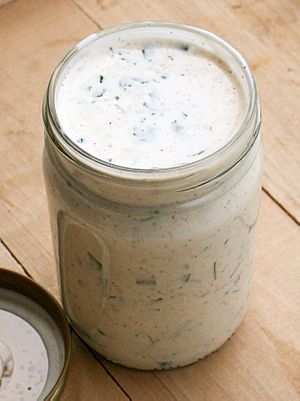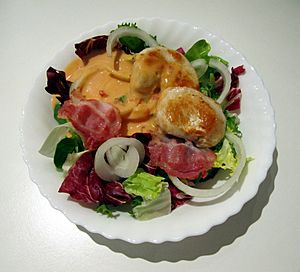Ranch dressing facts for kids

Homemade ranch dressing
|
|||||||
| Type | Salad dressing or dip | ||||||
|---|---|---|---|---|---|---|---|
| Place of origin | United States | ||||||
| Region or state | Alaska | ||||||
| Created by | Steve Henson | ||||||
| Invented | Early 1950s | ||||||
| Main ingredients | |||||||
| 145 (per serving) kcal | |||||||
|
|||||||
Ranch dressing is a very popular American salad dressing. It is usually made with buttermilk, salt, garlic, and onion. It also includes herbs like chives, parsley, and dill. Spices such as pepper and paprika are often added too. These ingredients are mixed into a sauce. The sauce is usually based on mayonnaise or another oil mixture. Sometimes, sour cream or yogurt is used instead of, or with, buttermilk and mayonnaise.
Ranch dressing has been the top-selling salad dressing in the United States since 1992. It became more popular than Italian dressing that year. People in the U.S. also love it as a dip. You can find ranch flavoring on potato chips and other snacks. In 2017, a study showed that 40% of Americans chose ranch as their favorite dressing.
Contents
The Story of Ranch Dressing
The story of ranch dressing began in the early 1950s. A man named Steve Henson (1918-2007) invented it. He was from Thayer, Nebraska. In 1949, Steve and his wife moved to Anchorage, Alaska. He worked there as a plumbing contractor. He worked in the remote Alaskan bush for three years.
Steve wanted to keep his workers happy. So, he created a new salad dressing for them. His plumbing business did very well. This allowed him to retire at age 35. He and his wife then moved to Santa Barbara County, California.
After a year and a half, Steve bought a place called Sweetwater Ranch in 1956. He renamed it Hidden Valley Ranch. When he made the menu for the ranch kitchen, he served his special salad dressing. The guests loved it a lot.
The dressing became so popular that Steve started selling it. He first mixed a batch for a friend, Audrey Ovington. She owned a place called Cold Spring Tavern. This tavern became the first business to buy his dressing. By 1957, you could buy a packaged mix to make the dressing at home.
Steve began selling the mixes by mail. Each package cost 75 cents. Soon, his whole house was used for the business. By the mid-1960s, the guest ranch closed. But Steve's "ranch dressing" mail order business was booming.
In the early 1970s, Steve realized the business was too big. He couldn't run it from the ranch anymore. The Hensons started a company called Hidden Valley Ranch Food Products, Inc. They opened a factory to make more dressing. They first sold it in supermarkets in the Southwest. Later, it was sold all over the country.
The company grew even more. In October 1972, a big company called Clorox bought the Hidden Valley Ranch brand. They paid $8 million for it. Steve Henson retired again after this sale.
Ranch Dressing Becomes Even More Popular
After Clorox bought Hidden Valley Ranch, they made some changes. They wanted to make the dressing easier for people to use. One change was adding buttermilk flavoring to the mix. This meant people could use regular, less expensive milk to make the dressing.
In 1983, Clorox created a new version. This was a bottled dressing that did not need to be kept in the fridge. This made ranch dressing even more convenient. By 2002, Clorox was making ranch packets and bottled dressings in two large factories. These factories were in Reno, Nevada, and Wheeling, Illinois.
During the 1980s, ranch flavor became popular in snack foods. The first was Cool Ranch Doritos in 1987. Then came Hidden Valley Ranch Wavy Lay's in 1994.
In the 1990s, Hidden Valley also made ranch dressings for kids. These had fun flavors like pizza, nacho cheese, and taco.
Ranch Dressing Today
Ranch dressing is still very popular today. If you search for it online, you will find millions of results.
Many different companies make ranch dressing. Some of these include Hidden Valley, Kroger, Ken's, Kraft, Litehouse, Marie's, Newman's Own, and Wish-Bone.
See also
 In Spanish: Aderezo ranchero para niños
In Spanish: Aderezo ranchero para niños


